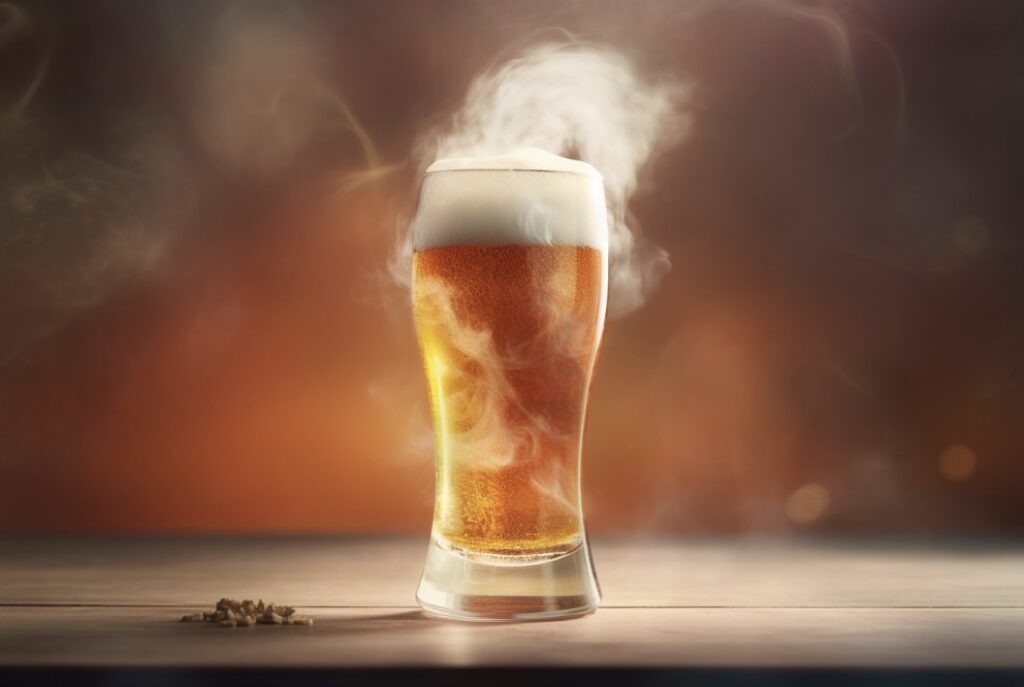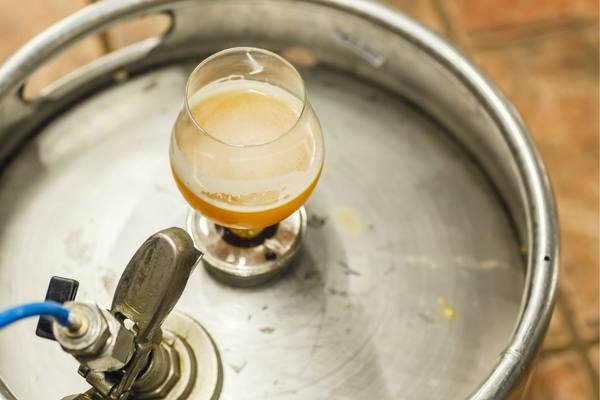Beer is carbonated because the carbonation adds fizziness, enhances flavors, and improves mouthfeel.
This reaction occurs when carbon dioxide (CO2) gas is dissolved into the beer, either naturally through fermentation or artificially by forced carbonation.
The topic of carbonation in beer is fascinating, and as an experienced brewer, I’ve seen firsthand how the right level of carbonation can make a good beer great.
In this blog post, I’ll discuss the various reasons why beer is carbonated, as well as the different methods of carbonation and their effects on the final product.
The Science Behind Carbonation
The Chemistry of Carbonation
Carbonation occurs when CO2 gas is dissolved in liquid, creating carbonic acid. This weak acid affects the pH level of the beer, which in turn influences the flavor and mouthfeel. The bubbles produced by carbonation also release volatile aroma compounds, enhancing the overall sensory experience of the beer.
The Role of Yeast in Natural Carbonation
Natural carbonation happens during fermentation, when yeast consumes sugars and produces CO2 as a byproduct. In traditional brewing methods, this CO2 is trapped in the beer, dissolving into the liquid and creating carbonation.
This process can be controlled by the brewer, who can adjust the amount of sugar and yeast used, as well as the temperature and duration of fermentation, to achieve the desired level of carbonation.
How was carbonated beer invented?
The discovery of carbonation in beer is an interesting historical development that occurred over centuries, involving various factors such as fermentation, container technology, and scientific understanding.
Let’s delve into the story.
Beer, in its early forms, was not naturally carbonated. It was primarily a result of the fermentation process where yeast consumes sugars, producing alcohol and releasing carbon dioxide (CO2) as a byproduct. However, in the absence of a sealed container, the CO2 would escape into the atmosphere, leaving the beer flat.

The knowledge of carbonation itself can be traced back to ancient civilizations. The ancient Greeks and Romans were aware of naturally carbonated mineral springs, where bubbling gases were observed.
These springs piqued the curiosity of philosophers and naturalists, but the connection to beer carbonation was not immediately made.
Fast forward to the Middle Ages, when beer was a staple beverage in many European societies. Brewers and beer drinkers noticed occasional carbonation in beer, but it was seen as an irregularity or flaw.
In fact, breweries often went to great lengths to eliminate excess carbonation by storing and tapping the beer when it had settled.
The pivotal moment came with the development of stronger glass bottles in the 17th and 18th centuries. Prior to this, bottles were typically made of weak and fragile materials such as pottery or leather, unable to withstand the pressure created by carbonation.
With the advent of stronger glass bottles, it became possible to seal the beer effectively, preserving the CO2 within the container.
Around the same time, scientists began to investigate the phenomenon of carbonation. In the late 17th century, English physicist and chemist Robert Boyle conducted experiments on carbonated water and made significant contributions to our understanding of gases. His work laid the foundation for further exploration of carbonation in beverages.
As beer was now being stored and transported in sealed glass bottles, the CO2 produced during fermentation had nowhere to escape.
This led to the gradual realization that the trapped carbon dioxide created pleasant effervescence, improving the taste and mouthfeel of the beer. Brewers began intentionally allowing carbonation to occur and even experimented with different techniques to enhance it.

The Industrial Revolution in the 18th century brought further advancements in brewing and bottling technology. Mass production of glass bottles became possible, making carbonated beer more accessible to the general population. This, coupled with the growing scientific understanding of carbonation, popularized the practice of carbonating beer intentionally.
In summary, the discovery of carbonation in beer was a gradual process spanning centuries. Beer was not naturally carbonated, but the development of stronger glass bottles allowed brewers to capture and retain carbon dioxide during fermentation.
This, along with scientific progress and improved container technology, led to the intentional carbonation of beer and the recognition of its enjoyable effervescence.
The Benefits of Carbonated Beer
Enhanced Flavor and Aroma
Carbonation improves the perceived flavor of beer by releasing volatile aroma compounds and creating a slight acidity from the carbonic acid. This acidity can help balance the sweetness of the malt and the bitterness of the hops, creating a more rounded and complex flavor profile.

Improved Mouthfeel
Carbonation contributes to the mouthfeel of the beer, with the bubbles providing a pleasant tingling sensation on the tongue and palate. The carbonation also helps to cleanse the palate between sips, allowing the drinker to better appreciate the flavors and aromas of the beer.
Better Head Retention
A well-carbonated beer will produce a thick, creamy head that lasts throughout the drinking experience. This head not only adds to the visual appeal of the beer but also helps to trap aroma compounds, enhancing the beer’s overall sensory experience.
Methods of Carbonation
Natural Carbonation
As mentioned earlier, natural carbonation occurs during fermentation, when the yeast consumes sugars and produces CO2. This method is commonly used in traditional brewing styles, such as bottle-conditioned ales and cask ales, which are served with a lower level of carbonation than many modern beers.
Forced Carbonation
Forced carbonation involves injecting CO2 gas directly into the beer after fermentation has been completed.
No matter if done by kegging or a simple sodastream type machine, the ideas is to make carbon dioxide dissolve in the beer.

This method allows for precise control over the level of carbonation and is commonly used in commercial brewing and homebrewing alike.
Carbonation Levels in Different Beer Styles
Different beer styles call for different levels of carbonation, which can greatly impact the overall experience of the beer. Here are a few examples:
High Carbonation: Belgian Tripels and Wheat Beers
These styles typically have a high level of carbonation, which helps to accentuate their fruity and spicy flavors and aromas, as well as their light, effervescent mouthfeel.
Medium Carbonation: IPAs and Pale Ales
Most IPAs and pale ales have a medium level of carbonation, which balances their hop-forward flavors and aromas with a satisfying mouthfeel.
Low Carbonation: English Bitters and Stouts
These styles traditionally have a lower level of carbonation, which enhances their smooth, creamy mouthfeel and allows their malt-forward flavors to shine.
Conclusion
Beer is carbonated to enhance its flavor, aroma, and mouthfeel, making for a more enjoyable drinking experience. Carbonation can occur naturally through fermentation or can be artificially introduced through forced carbonation. Different beer styles call for different levels of carbonation, and finding the right balance is an essential part of the brewing process.
10 Facts About Beer Carbonation
1. Carbonation is the process of dissolving CO2 gas in liquid.
2. Carbonation creates carbonic acid, which affects the pH level of the beer.
3. Natural carbonation occurs during fermentation, when yeast consumes sugars and produces CO2.
4. Forced carbonation involves injecting CO2 gas directly into the beer after fermentation.
5. Carbonation enhances the flavor and aroma of the beer by releasing volatile compounds.
6. The bubbles produced by carbonation improve mouthfeel and cleanse the palate.
7. A well-carbonated beer will produce a thick, creamy head with good retention.
8. Different beer styles call for different levels of carbonation.
9. High carbonation is often found in Belgian Tripels and wheat beers.
10. Low carbonation is typical in English bitters and stouts.
FAQs
When did beer start being carbonated?
Beer started being carbonated around the late 17th to early 18th century. The process of carbonation was initially achieved through natural fermentation in the bottle or cask, but later advancements in technology allowed for artificial carbonation methods to be employed.
Is beer supposed to be carbonated?
Yes, beer is typically carbonated. Carbonation is a key characteristic of beer and is achieved through the process of fermentation. During fermentation, yeast consumes sugars and produces carbon dioxide, which dissolves into the beer, creating carbonation. However, there are also some beer styles, such as traditional cask ales or certain Belgian styles, that are intentionally served with lower levels of carbonation.
Is beer meant to be carbonated?
Yes, beer is typically meant to be carbonated. Carbonation adds effervescence, enhances aroma and flavor, and contributes to the overall sensory experience of beer. While there are some beer styles that may be intentionally low or non-carbonated, the majority of beers are carbonated to varying degrees.
What beer is not carbonated?
Non-alcoholic beers are typically not carbonated. Some examples include non-alcoholic lagers, pilsners, and wheat beers. These beverages go through a process called “decarbonation” to remove the carbonation, resulting in a flat or less fizzy drink.
Do all beers have carbonation?
No, not all beers have carbonation. While carbonation is a common characteristic of many beer styles, there are some beers, such as some traditional English ales or cask-conditioned beers, that are often served with minimal or no carbonation. Additionally, certain specialty or experimental beers may intentionally be made without carbonation for specific flavor or mouthfeel purposes.
Why does beer have to be carbonated?
Beer is carbonated to enhance its taste, aroma, and mouthfeel. Carbonation adds a refreshing and effervescent quality to beer, making it more enjoyable to drink. It also helps release the beer’s aromas, enhancing the overall sensory experience. Additionally, carbonation contributes to the beer’s mouthfeel, providing a pleasant and lively sensation on the palate.




